Blog
Discover the four layers of the forest—and the animals living in it
Read moreAnimals of the Galápagos Islands
The Galápagos Islands are a hotspot for global biodiversity, with one of the highest levels of unique species in the world. Around 97% of the reptile species, 80% of the land-dwelling birds, 20% of the marine animals, and 30% of the plants in these islands are endemic to the Galápagos, meaning they are found nowhere else. This significantly high population of endemic species is largely thanks to the islands’ isolation, as they are located approximately 1,000 kilometres (600 miles) west of mainland Ecuador.
This amount of endemic species, found nowhere else in the world, can also be attributed to the islands’ unique environmental conditions. The Galápagos includes 13 major islands, 6 smaller islands, and many islets and rocks, occupying a total land area of 8,010 square kilometres (3,093 square miles) and over 59,500 square kilometres (23,000 square miles) of ocean.
The Galápagos islands are considered to be geologically young, having formed approximately 700,000 to 5,000,000 years ago. They were formed from volcanic activity, with periodically active shield volcanoes spread throughout the archipelago.
The Galápagos feature distinct ecological zones, each with its own climate and vegetation. The arid lowlands of the region are covered with an open cactus forest, while a more elevated transition zone features a pisonia forest interspersed with guava trees. Above the transition zone, the islands are covered by a moist forest region dominated by a Scalesia forest. The upland zone is treeless, covered with grasses and ferns. The general climate of the Galápagos is relatively mild, with low rainfall and humidity and relatively low temperatures.
The archipelago’s ecosystem consists of an array of fascinating animals that have adapted to the habitat. Animals on the islands have evolved to cope with the challenges of the climate—including the unique features of each individual island. For example, the famous Galápagos giant tortoises can survive for long periods without food or water, thanks to their slow metabolism, and there are various tortoise subspecies on the different islands that have evolved distinctly thanks to their geographical separation. Darwin’s famous finches are another great example of this phenomenon.
Because of climate change, human activity, and other threats, many of the animals that call the Galápagos home are unfortunately vulnerable to extinction. As a conservation and rescue organisation that works around the world to help wildlife, IFAW is here to tell you about the most fascinating species that inhabit these islands, the threats they face, and the important roles they play in their unique ecosystems.
Let’s explore some of the most iconic species found in the Galápagos.
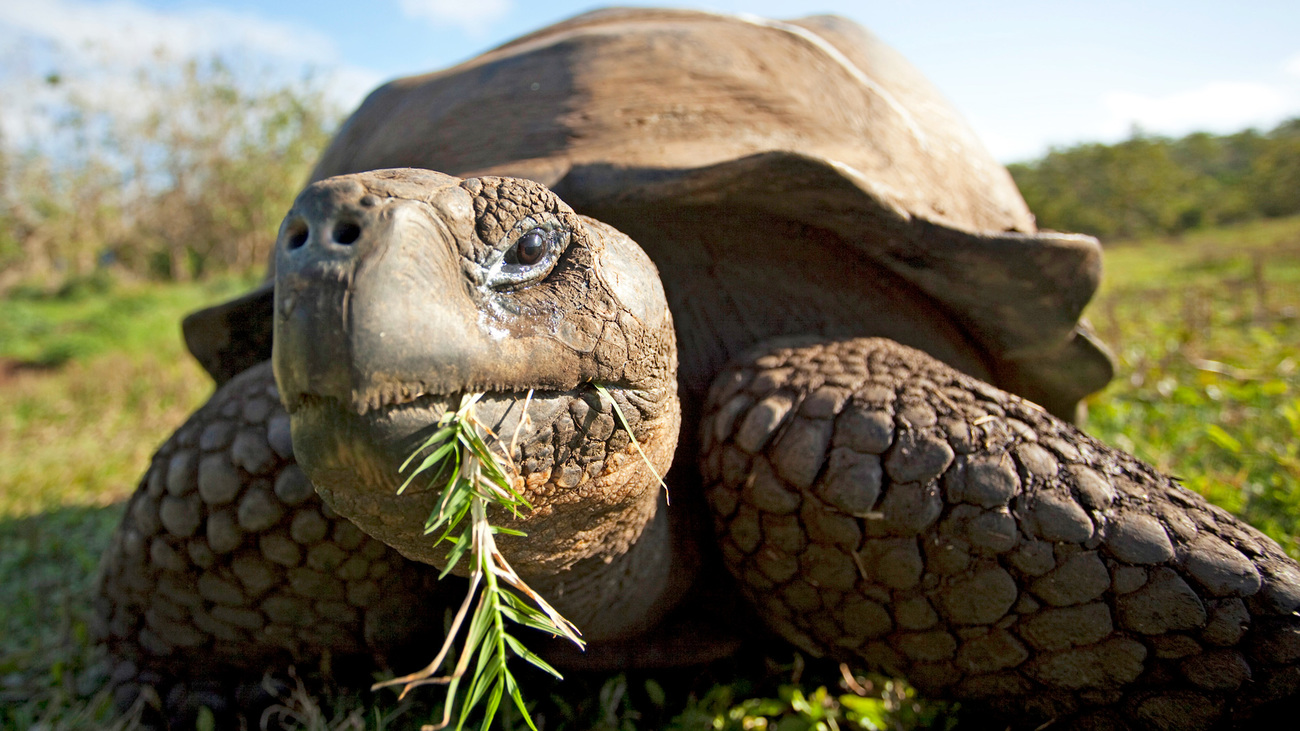
The Galápagos giant tortoises are perhaps the most famous residents of the islands. They’re found across the Galápagos, particularly on some of the larger islands such as Isabela, Santa Cruz, and San Cristóbal. They are the largest living tortoises in the world, with some individuals growing over 1.3 metres (4.2 feet) in length and weighing up to 300 kilograms (over 660 pounds).
These herbivorous reptiles feed on grasses, leaves, cacti, and other vegetation. Their slow metabolism allows them to survive for over a year without food or water, an adaptation that has been crucial for survival in the Galápagos’ arid environment. Galápagos giant tortoises have evolved into various different subspecies, each with their own unique adaptations. For example, tortoises on islands with taller vegetation—such as tree cactus—have evolved to have saddle-shaped shells that allow them to lift their heads higher to reach food.
The giant tortoises of the Galápagos face numerous threats to their survival, from human-driven poaching and habitat loss to invasive plant species occupying the land and invasive animal species interrupting the food web. There are currently 12 surviving subspecies of Galápagos giant tortoise, most of which are endangered. Sadly, some of these subspecies are critically endangered, including:
Many of these tortoises have populations of only a few hundred or even fewer than one hundred.
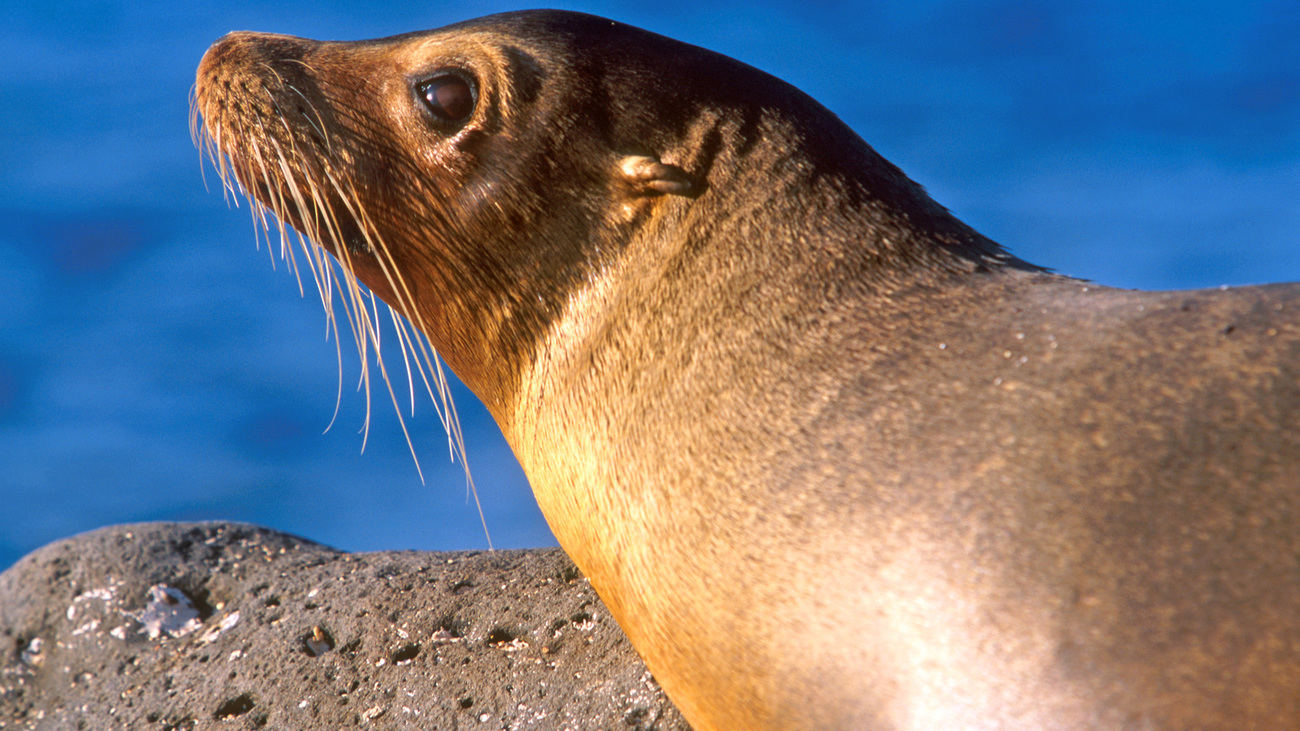
Another iconic species of the Galápagos is the Galápagos sea lion. This species is commonly found along coastal areas and occasionally on mainland Ecuador. These mammals have brown to dark brown fur, and adult males sport a distinctive forehead bump.
Carnivorous by nature, the diet of a Galápagos sea lion consists of fish, squid, and octopus. They are well adapted to their marine environment, with sleek, streamlined bodies and powerful flippers contributing to their fast and agile swimming. They can also regulate their body temperatures to thrive in cold waters.
The IUCN classes the Galápagos sea lion as endangered. They are threatened by entanglement in fishing gear, competition for food due to overfishing, and diseases introduced by domestic animals. Conservation efforts are crucial to ensuring the survival of this incredible species.
The Galápagos penguin is the only penguin species found north of the equator, primarily inhabiting the islands of Fernandina and Isabela, with smaller populations on other islands. These small penguins feature black backs and white undersides, with a distinctive white band running under their chins.
Galápagos penguins are carnivorous, primarily eating small fish like anchovies and sardines. They are uniquely adapted to warmer climates, though they can swim and hunt efficiently in cold ocean currents like the Humboldt Current.
Unfortunately, the Galápagos penguin is endangered. This species is particularly threatened by climate change, as well as food scarcity due to El Niño events. Oil spills also have a huge impact on the survival of Galápagos penguins, as do the increased chances of predation from introduced predators.
Darwin’s finches, also known as the Galápagos finches, are a group of 18 bird species that have become famous for their role in Charles Darwin’s theory of evolution. These small birds are found across all the Galápagos Islands, with each species featuring adaptations to specific islands or habitats.
Their most recognisable adaptations are their beaks, which have evolved into various shapes and sizes to allow them to access different food sources, such as seeds, insects, nectar, and fruit. The diversity within their beaks has enabled these birds to adapt rapidly to environmental changes, making them a prime example of adaptive radiation.
While most of Darwin’s finch species are classed by the IUCN as least concern, some are unfortunately vulnerable or endangered. The medium tree finch and the mangrove finch are both critically endangered due to various threats, including habitat loss, competition with invasive species, and climate change.
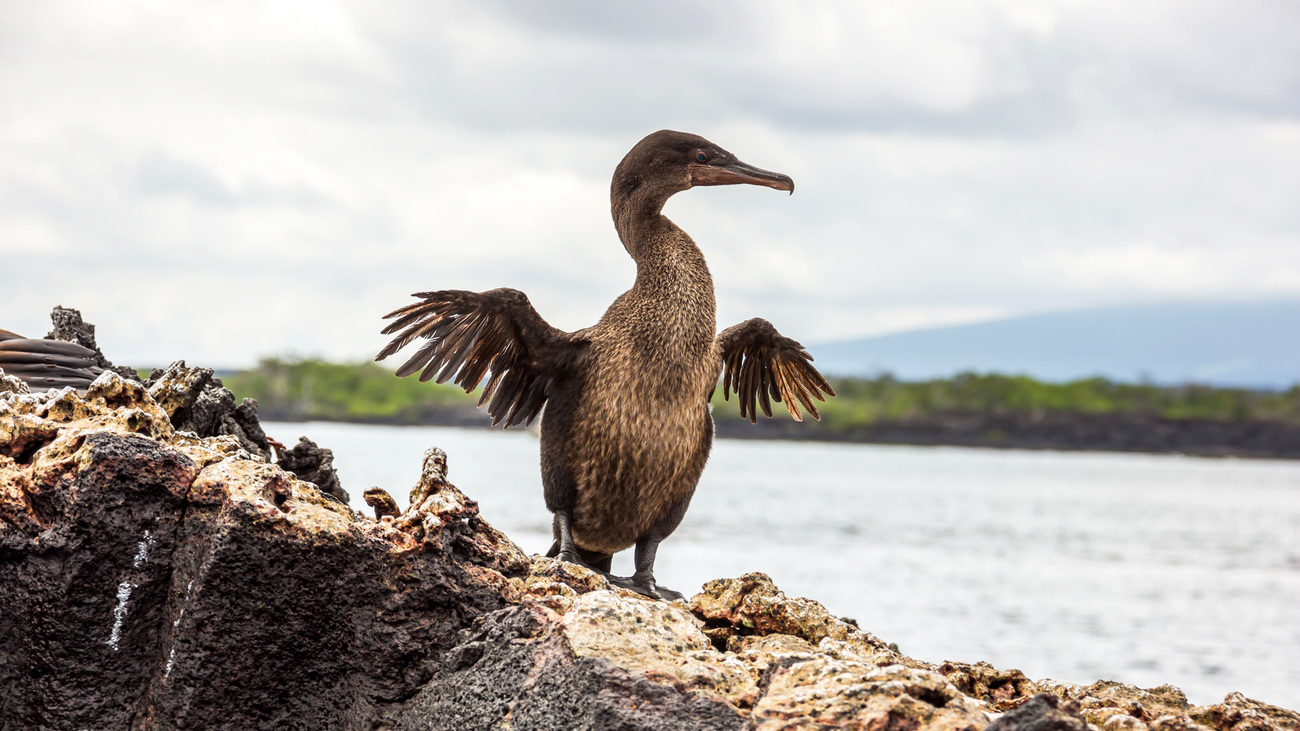
The flightless cormorant is native to the western Galápagos Islands, primarily Fernandina and Isabela. These large dark brown and black birds have small wings, blue eyes, and a long neck with a hooked beak.
As their name would suggest, this bird species cannot fly. They lost this ability due to their lack of natural predators and their need to swim efficiently to catch prey. They are a carnivorous bird species with a diet mainly consisting of fish and octopus.
The IUCN classifies the flightless cormorant as vulnerable. Their population faces threats from climate change, oil spills, introduced predators, and volcanic eruptions. Protecting their habitat and mitigating these threats are critical to their survival.
Galápagos fur seals are found around the coastal regions of the islands, especially around the rocky shores. They’re smaller than the Galápagos sea lions, with dense, dark brown fur and short, pointed snouts.
These fur seals feast on fish and squid, hunting at night when their prey is more abundant. They have dense fur that aids in their nocturnal hunting activities, providing insulation against the cold waters of the Pacific Ocean at night.
Galápagos fur seals are endangered, facing threats from overfishing (which removes their food source), entanglement in fishing nets, and climate change.
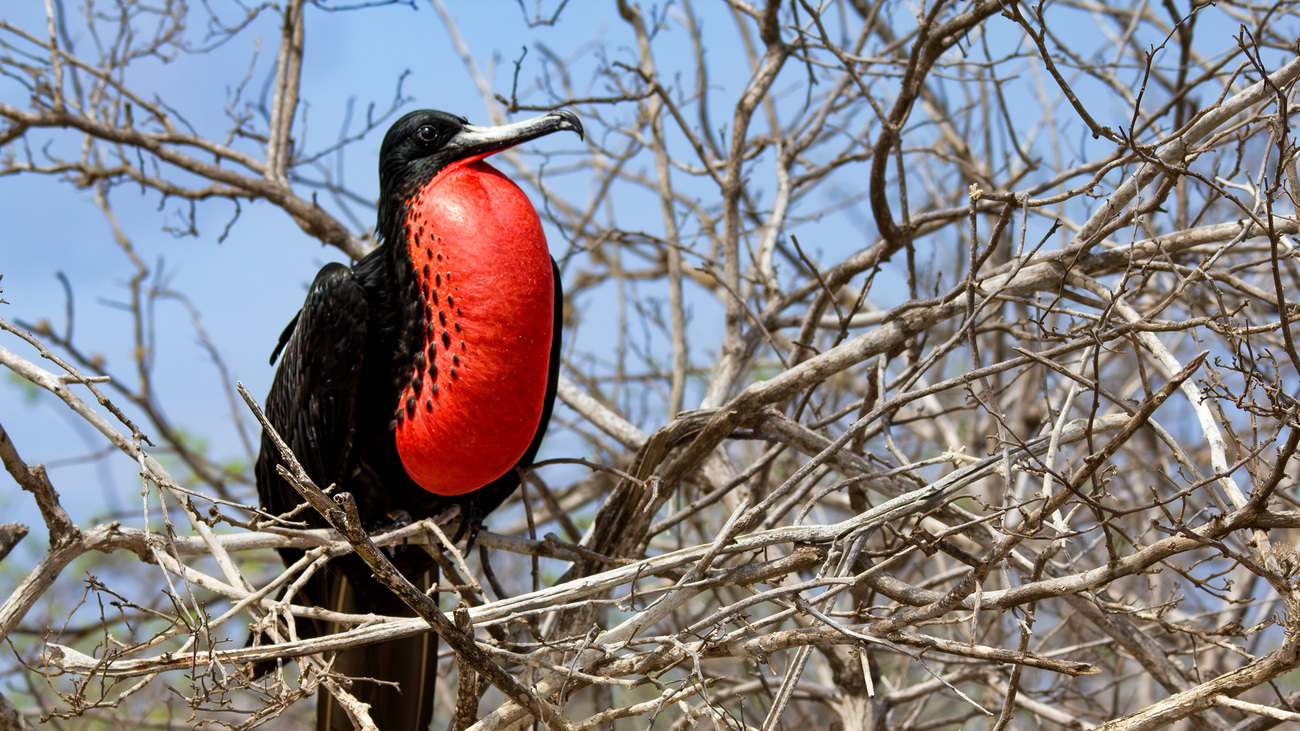
The magnificent frigatebird can often be seen soaring over the Galápagos, though it is also found in other tropical regions. It is a large seabird with a long, forked tail and large, dark wings. Male magnificent frigatebirds are characterised by red inflatable throat pouches, which they use to attract mates during the breeding season.
These birds are carnivorous, feeding mainly on fish and squid. They have a unique way of capturing their prey, often allowing other birds to hunt and then stealing their catch, in a behaviour known as kleptoparasitism. This kleptoparasitism is viewed as an adaptation of the species that allows them to conserve energy rather than expend it on hunting activities. Magnificent frigatebirds are also excellent gliders, capable of staying aloft for long periods with minimal energy usage.
Though they are currently classed as least concern on the IUCN Red List, the species faces threats from habitat destruction, human disturbance, and introduced predators. Protecting their nesting sites and minimising human impact is essential for their conservation.
Galápagos sharks are a medium to large shark species, found in the shallow reefs and rocky coastal waters of the Galápagos islands. These sharks are greyish-brown with a white underside, pointed snout, and slender body.
They have evolved to be quick and agile swimmers, making them effective predators. They primarily feed on fish, squid, octopus, and even seabirds on occasion. As a top predator in the Galápagos food web, these sharks play an important role in regulating the populations of their prey species.
The IUCN classes the Galápagos shark as near threatened, facing threats from overfishing, bycatch in fishing nets, and habitat degradation.
Living on the rocky shores of the Galápagos, the marine iguana is the only marine lizard species in the world. These dark grey to black iguanas are characterised by their laterally flattened tails and spiky dorsal fins, and males often display brighter colours during the mating season.
Marine iguanas mainly feed on algae, which they graze off underwater rocks. They have evolved to be able to shrink in body length as well as weight when there are limited food sources. Plus, they have very strong limbs and claws, which allow them to cling to rocks in stronger currents.
This unique reptilian species is classed as vulnerable. They are threatened by the effects of climate change, El Niño events, environmental pollution, and introduced predators.
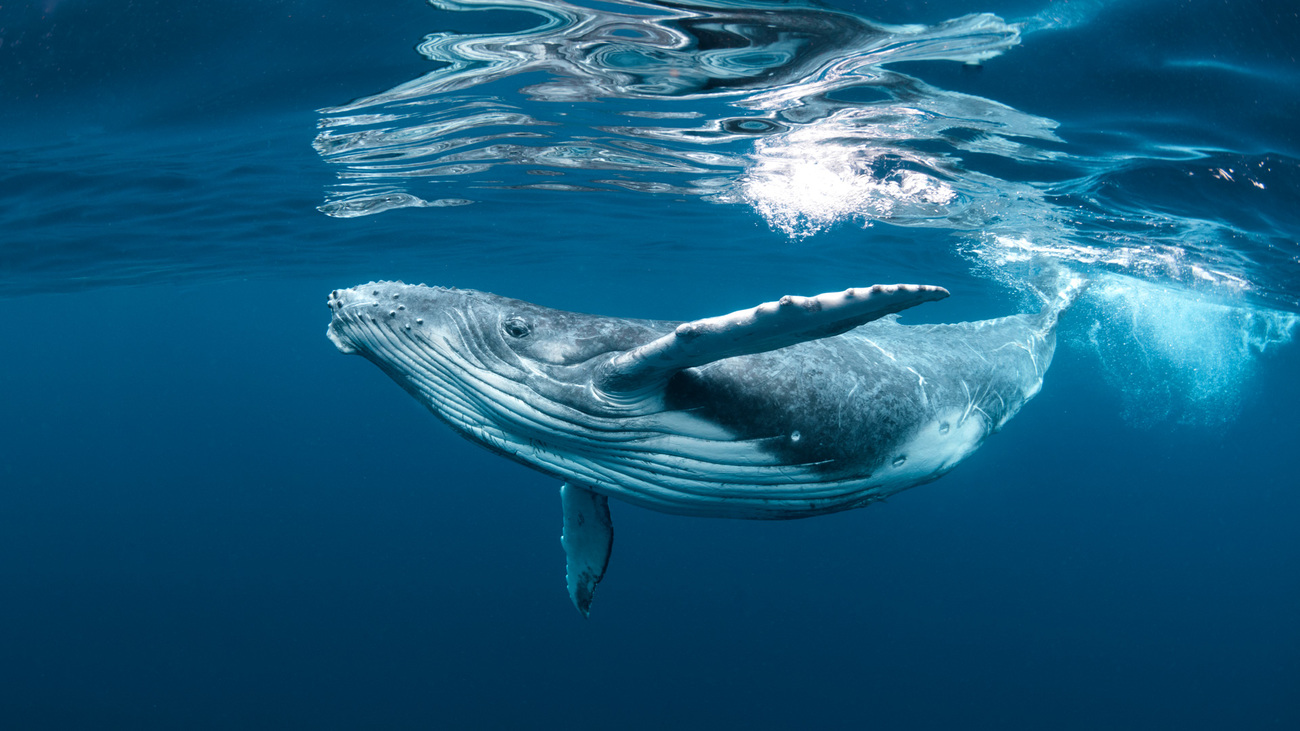
Humpback whales are a migratory species that can be seen around the Galápagos Islands during their breeding season, particularly in cooler waters. These large baleen whales are recognised by their long pectoral fins, knobby heads, and distinctive black and white patterning. They can often be seen breaching out of the water in spectacular fashion.
Humpbacks feed mainly on plankton, krill, and other small fish, filtering through their huge baleen plates. Their long migration patterns between feeding and breeding grounds allow them to take advantage of seasonal food resources.
Though currently classed as least concern, humpback whales face significant threats to their survival, including entanglement in fishing gear, collisions with ships, ocean noise pollution, and climate change.
The Galápagos hawk is a predatory bird species found around most islands in the Galápagos, though it prefers the drier and open habitats. The Galápagos hawk is a large, broad-winged raptor with dark brown plumage, yellow legs, and a sharp, hooked beak.
This beak comes in handy when hunting for prey. As a predatory bird, the Galápagos hawk mainly consumes small mammals, birds, reptiles, and carrion. As the top predator in the Galápagos islands, this hawk species plays a critical role in controlling the populations of many other species in the food chain.
The Galápagos hawk is classed as vulnerable by the IUCN. The species is threatened by habitat loss, persecution from humans, and reduced prey due to environmental changes.
The red rock crab, also known as the Sally lightfoot crab, is found on the rocky shorelines of the Galápagos and Central and South America. They have bright red or orange shells with blue underparts, scuttling around on five pairs of legs and snapping their sharp claws.
Red rock crabs are omnivorous, consuming a combination of algae, detritus, and small invertebrate creatures. They’re well adapted to the shores of the Galápagos. As agile climbers, they thrive in the harsh, wave-swept intertidal zone.
This crab species is one of the most abundant crab species off the western coast of South America and has not been assessed by the IUCN. However, they still face threats from increased predation by introduced species, habitat disturbance, and pollution.
Want to support IFAW in our mission of helping animals and people thrive together?
Our work can’t get done without you. Please give what you can to help animals thrive.
Unfortunately, the browser you use is outdated and does not allow you to display the site correctly. Please install any of the modern browsers, for example:
Google Chrome Firefox Safari